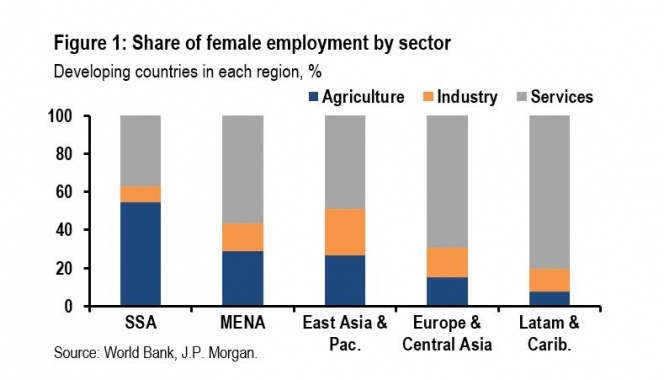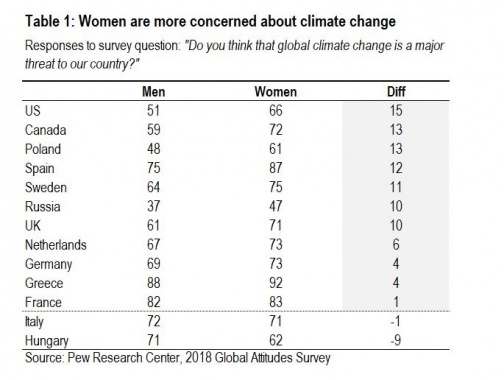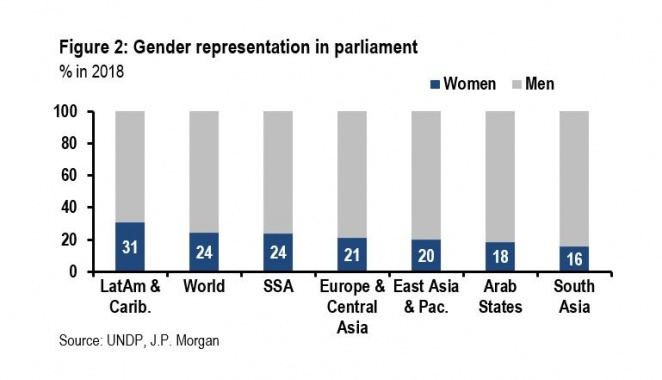

To assess who is most vulnerable to climate change, one must consider that climate change exacerbates existing vulnerabilities. For this reason, low-income emerging market economies are considered most at risk from a changing climate. They often already experience high temperatures, rely heavily on their agricultural sectors, and possess fewer resources to invest in adaptation and mitigation. Climate change—that is, temperature rise, but also increased frequency and intensity of extreme weather events (floods, storms, droughts)—will aggravate such vulnerabilities. It follows then, that gender disparities, both economic and social, will also be worsened under climate change. Drawing on the wealth of research from the United Nations Development Programme, this note explores climate change from a gendered perspective.
Those most vulnerable in society, from an economic and social standpoint, are deemed the most vulnerable to climate change. Indeed, that includes women, but there is an intersection between children, the elderly, indigenous people, and those with disabilities. While much research focuses on women in low-income developing regions, it is worth noting that women in high-income regions are also at a climate disadvantage and are also less represented in political circles, despite typically showing more concern for climate change and the impact on future generations.
Women face elevated risks from natural disasters—the frequency and intensity of which will be greater under climate change—as well as in their unique exposure to natural resources. Women are also less able to influence the adaptation and mitigation of climate change because of a generally weaker economic standing (poorer, limited access to credit) amid less representation in the political sphere. It is such pervasive inequalities, rather than biological sex, that are found to disadvantage women in the face of climate change.
Natural disasters are found to inflict higher fatality rates on women compared to men, usually due to inadequate access to information or early warnings, as well as limited access to resources that can build resilience1. The disparity is stark in developing countries. There are a number of reasons for this; most revolve around societal, cultural and religious norms. Since women typically bear the burden of child and elderly care, they are more likely to be at home taking care of others when disasters hit, thus escaping is made more challenging. To illustrate, during Hurricane Harvey in 2007, many women chose not to evacuate, as caring burdens complicate the decision to leave.2 This is complicated further in communities where women require permission of a male relative to travel, or even leave the house. Victims of a 1991 cyclone in Bangladesh were 90% women, in part, because warning messages were delivered to men in public spaces but did not reach the women waiting in their homes.3
Countries that rely heavily on agriculture are vulnerable to climate change, as a warmer climate, altered weather patterns, droughts, floods and soil degradation weigh on natural resources and agricultural production. This is expected to exacerbate poverty and malnutrition in less-developed countries and poses a unique burden for women. While women’s participation in the agricultural sector is significant, especially in Sub-Saharan Africa (Figure 1), female land ownership is considerably smaller. In developing countries, women in agriculture generally have less access to productive resources, including land, technology and finance. This hampers their ability to adapt to climate change and thus renders women more vulnerable to food insecurity.6 Cultural norms may also prevent women from finding employment outside of agriculture, for example, in urban centers, in the way that men might in the event of an agricultural shock. Lastly, as women and girls in rural communities often bear the burden of resource collection, food and water scarcity will force them to spend more time on resource collection with less time for paid work or schooling.
Figure 1: Share of female employment by sector

While awareness and concern over climate change is rising globally, research finds that women are overwhelmingly more concerned about it than men (Table 1). This nuance is significant for environmental policy making: studies show that countries with higher female parliamentary representation are more likely to ratify international environmental treaties and set aside protected land areas.7 Studies also find positive correlation between the share of women on corporate boards, and the quality of carbon emissions disclosures.8
Table 1: Women are more concerned about climate change

But women are still overwhelmingly underrepresented in the political sphere, meaning they have limited opportunity to influence policy change(Figure 2).
Figure 2: Gender representation in parlament

A gendered perspective on climate change is critical to environmental policy making, in order to prevent widening existing gender gaps. As well as the effects of climate change itself, ignoring the distributional impact of climate policy may undermine gains made toward gender and social equality. For instance, a global tax on carbon—assumed necessary if we are to meet the Paris objective of limiting the temperature rise to below 2⁰C—will likely push up fuel costs for consumers. Due to a higher proportion of women in the poorest communities, a carbon tax risks subjecting more women (especially the elderly or single mothers) to poverty. Moreover, International Labour Organization warns that without overcoming gender disparities in the industrial sector, the transition to a low-carbon economy (and the associated rise in renewable energy, manufacturing, construction) would see the share of female employment lower than it would otherwise be.9 This highlights the importance of incorporating gender into green economy planning.
Women face a unique burden but also have a role to play in the fight against climate change—in adaptation and mitigation. At a micro level there are calls to engage with women in rural communities to leverage their local knowledge and better understand adaptation possibilities. Policy should also better tap into the unique role of women in disaster management and community resilience. At a macro level, especially in countries where female labor force participation is low, climate change represents an opportunity for women to enter non-traditional sectors, such as those relating to green energy transition. Financing for “climate-smart” agriculture also poses an opportunity, not just to strengthen the resilience of agriculture, but also to reduce the sector’s own contribution to global warming (agriculture generates some 24% of total greenhouse gas emissions) and to address gender imbalances.
This SUREF policy note includes research content published by J.P. Morgan on 9th March 2020. J.P. Morgan has granted SUREF a limited right to re-publish this research on an information only basis. J.P. Morgan has no liability in any regard for the publication of this SUREF policy note or SUREF’s decision to reproduce any J.P. Morgan research content contained herein. It is not an offer to buy or sell any security/instruments or to participate in a trading strategy or trading activity; nor does it constitute any form of personal financial advice or investment recommendation by J.P. Morgan. This information should not be relied upon for any reason whatsoever by any natural or legal person. For important current standard disclosures that pertain to J.P. Morgan’s research please refer to J.P. Morgan’s disclosure website: https://www.jpmm.com/research/disclosures
United Nations Development Programme (2013), “Gender and disaster risk reduction”
World Bank (2018), “Why we must engage women and children in disaster risk management”
Ikeda (1995), “Gender Differences in Human Loss and Vulnerability in Natural Disasters: A Case Study from Bangladesh”
United Nations Development Programme (2013), “Gender and adaptation – Policy Brief 2”
International Federation of Red Cross and Red Crescent Societies (2015), “Unseen, unheard: Gender-based violence in disasters”
United Nations Development Programme (2016), “Gender, climate change and food security”
United Nations Development Programme (2011), Human Development Report. Sustainability and Equity: A Better Future for All
Liao et al (2015), “Gender diversity, board independence, environmental committee and greenhouse gas disclosure”
International Labour Organization (2018) Submission to the UNFCCC regarding Gender and Climate Change